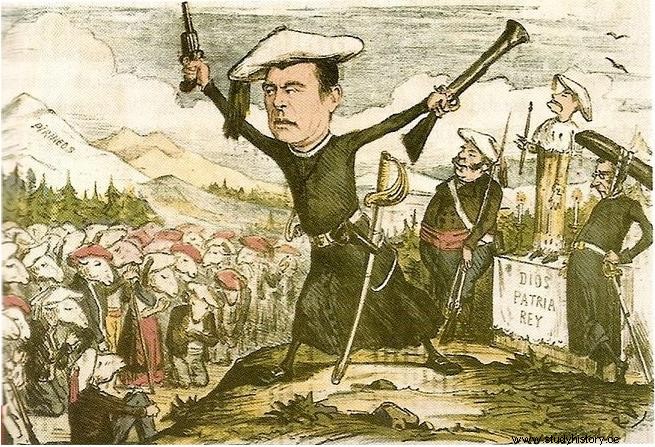
1. The origins of the Carlist conflict:the reign of Ferdinand VII.
Upon his return to Spain in May 1814, after his forced exile in France, King Ferdinand VII aroused great conflicting expectations. Everyone thought – nobility, Church, people – that his problems would be solved. However, the Spanish situation was one of deep crisis:a ruined agriculture, paralyzed trade and manufacturing, demographic losses and a rebellion in the Spanish Empire in America. Given this scenario, Fernando VII was cautious and restored a moderate absolutism, without annulling in a general way all the reforms implemented by liberalism. From that moment until the end of the 19th century, Spanish politics was determined by a dynamic of opposition between liberal and absolutist forces.
The most absolutist positions were concentrated around the figure of the king's brother, Don Carlos María Isidro, a very pious person and a clear supporter of absolutism – that is why his followers were called Apostolic or Carlist. This sector received with discomfort that the king did not restore the entire Old Regime and opposed the reformist measures, even if they were timid. The initial program of these apostolics, the seed of what would later become Carlism, can be summed up in three points:absolutism, the Inquisition and Royalist Volunteers.
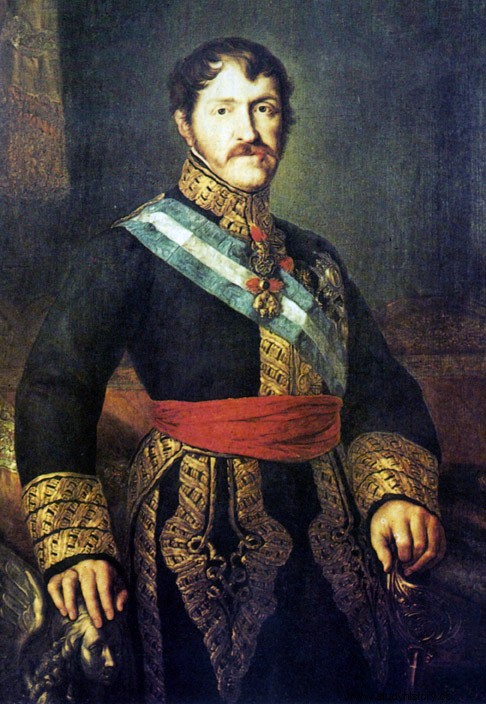
At the same time, taking advantage of the persistent economic crisis and social unrest in the countryside, the absolutists resorted to conspiracies and revolts to impose their ideology. In the last years of the reign of Fernando VII, the apostolic leaders, supported by the infante Carlos, dedicated themselves to planning a national insurrection based on the mobilization of up to two hundred thousand Royalist Volunteers. The objective was that when Carlos V –Carlos Mª Isidro– reached the throne he would annul all the reformist measures and return to the budgets of the Old Regime, with the Inquisition as ideological police.
Towards 1829 the situation worsened even more with the addition of some invasion attempts carried out by the Liberals, as well as a worsening of the financial crisis. Soon after, Amalia, King Ferdinand's third wife, died, and a few months later the King remarried his niece, María Cristina de Borbón-Dos Sicilias (December 1829). In March 1830 the Pragmatic Sanction was made public, already approved in 1789 under the reign of his father Charles IV, but not yet published. This rule abolished the so-called Salic Law, which prevented women from accessing the throne. Shortly after the pregnancy of the new queen was announced and Fernando ensured through his testament his will that his son or daughter succeed him, leaving the regency in the hands of his wife. The birth of the infanta Isabel, once the Salic Law had been repealed, separated Don Carlos from succession to the throne. With that possibility gone, the only thing left for the Carlists was the violent seizure of power.
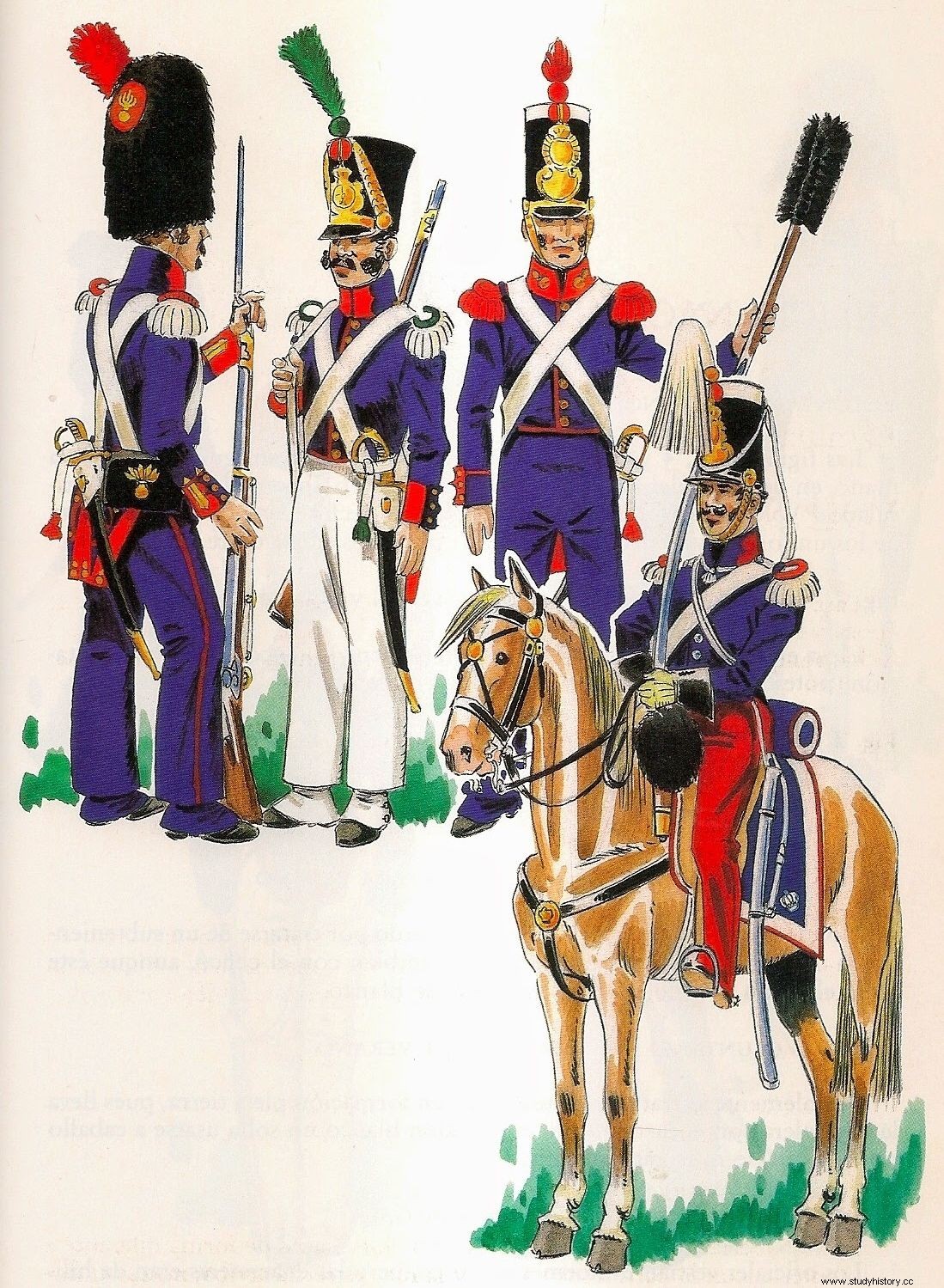
2. Regency of Mª Cristina and beginning of the conflict.
A few months later, in October 1830, Mª Cristina gave birth to a girl:the future Isabel II. Meanwhile, in the environment of the infante Carlos continuous conspiracies developed, directed mainly by the Portuguese infanta Francisca, who was the wife of Carlos. The great conspiratorial opportunity seemed to arise in September 1832, while the royal family was at La Granja.
Ferdinand suffered from serious gout attacks, a circumstance that some apostolic circles close to the Court took advantage of to frighten the queen and encourage her to restore the exclusion of women from the crown, arguing that if she did not do so, a revolution could take place that even end their lives. The queen then influenced the king to sign such a document on the condition that it be kept secret while the king lived. However, the news transcended, generating, among the noble elites, a movement in support of the queen. In addition, the king's health improved and he appointed a new government that applied a series of reformist measures –limited amnesty, purge of the Army, etc.–. These measures alarmed the Carlists.
When Ferdinand VII died (September 29, 1833), his wife Mª Cristina took over the regency for their daughter Isabel, a period that lasted until 1843. Cea Bermúdez continued as president of the government, maintaining a sterile immobility despite the fact that there had already been the Carlist insurrection. In addition, his attitude made it difficult to initiate the solutions, especially financial ones, that the country needed. The climate of civil war was palpable. In the meantime, Carlos had fled to Portugal where he declared that he refused to swear allegiance to Isabel and that he continued to maintain his rights to the throne.
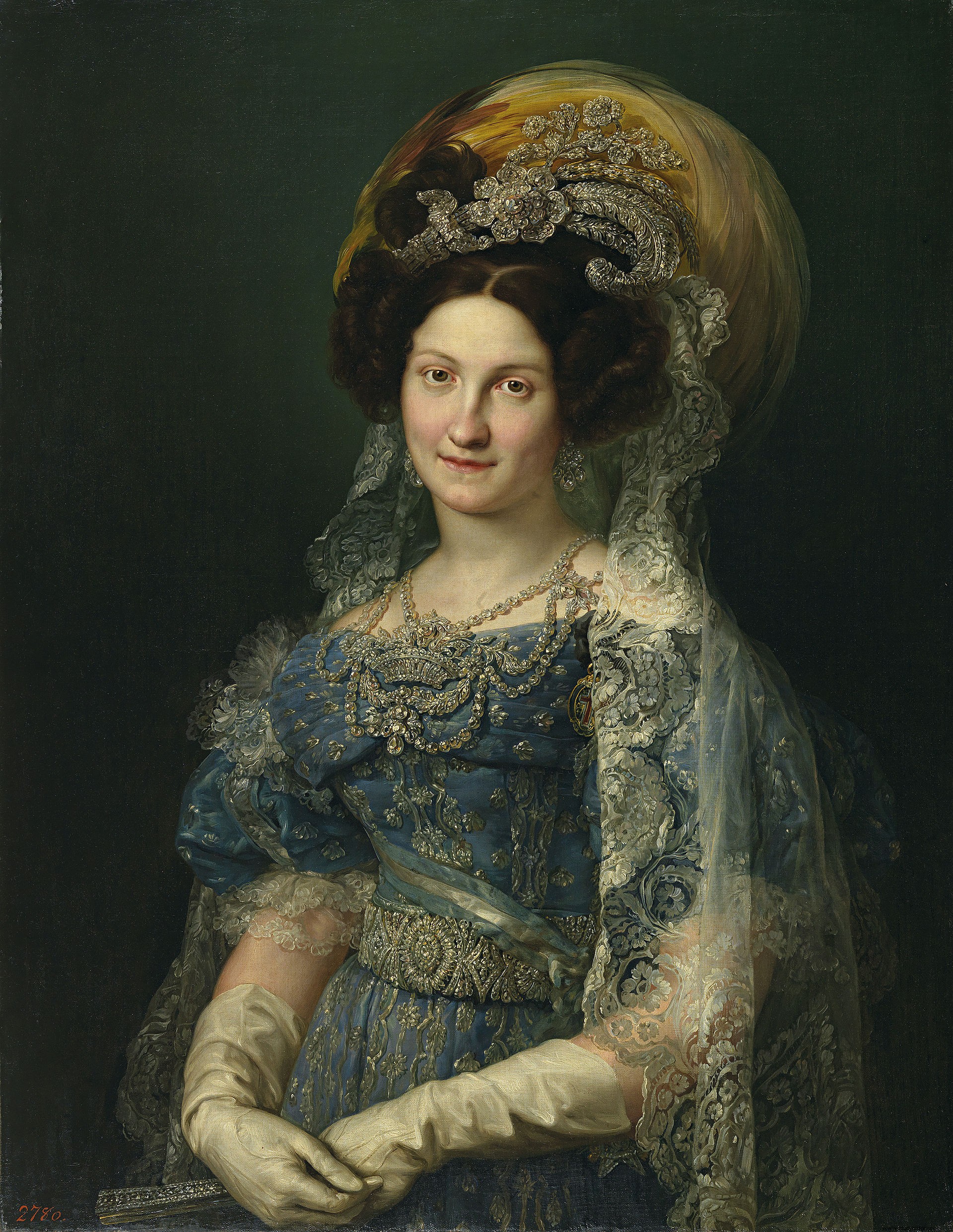
3. The first Carlist War (1833-1840)
The inactivity of the government meant that it was the general captains of each region who faced the first Carlist insurrection, limiting the conflict, in most of the national territory, to a war of parties, and not of fronts and great battles, a type of warfare that it only occurred in Navarra and the Basque Country, where an alternative government came to fruition.
The first phase of this conflict arose at the end of September 1833, when armed confrontations took place in Valencia, Castile, Navarra and the Basque provinces. In this last area, armed parties led by the Carlist colonel Zumalacárregui acted. Thanks to him, a kind of alternative monarchy was established in Navarre with some political and economic structures –court, government, services,…–, but its economic situation was disastrous. For this reason, it was intended to take Bilbao, in order to try to achieve some international recognition and, at the same time, demand a loan from the city. In the rest of the territories directly affected by the war –Catalonia, Aragón, La Mancha, etc.– mainly isolated guerrilla bands acted. In the siege of Bilbao, Zumalacárregui was killed (July 1835) and the failure of the operation ended the period of Carlist victories. His death put an end to this stage.
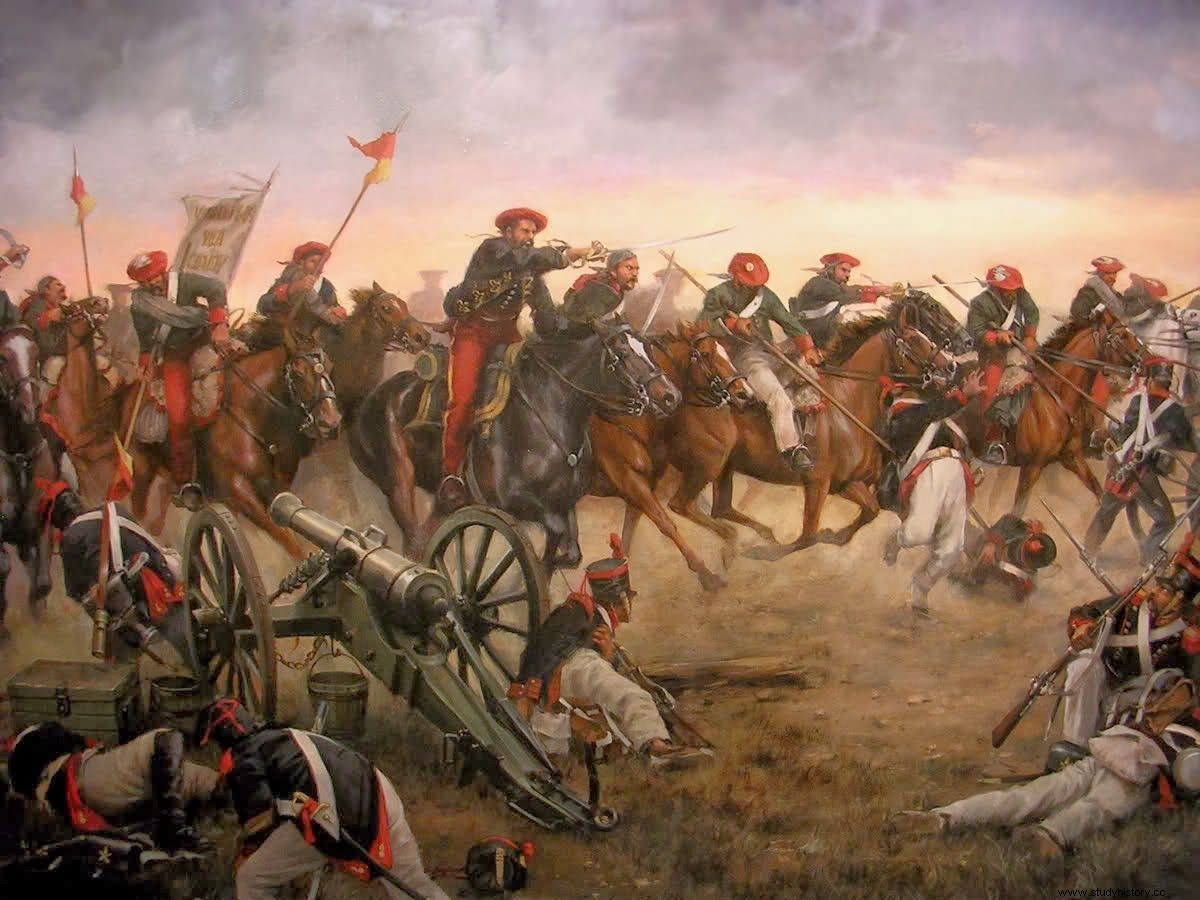
The second stage of the war took place between July 1835 and October 1837, and spread throughout the national territory. The Carlists organized expeditions to various parts of the peninsula –Galicia, Valencia, Andalusia, even Madrid–, but without any lasting political results.
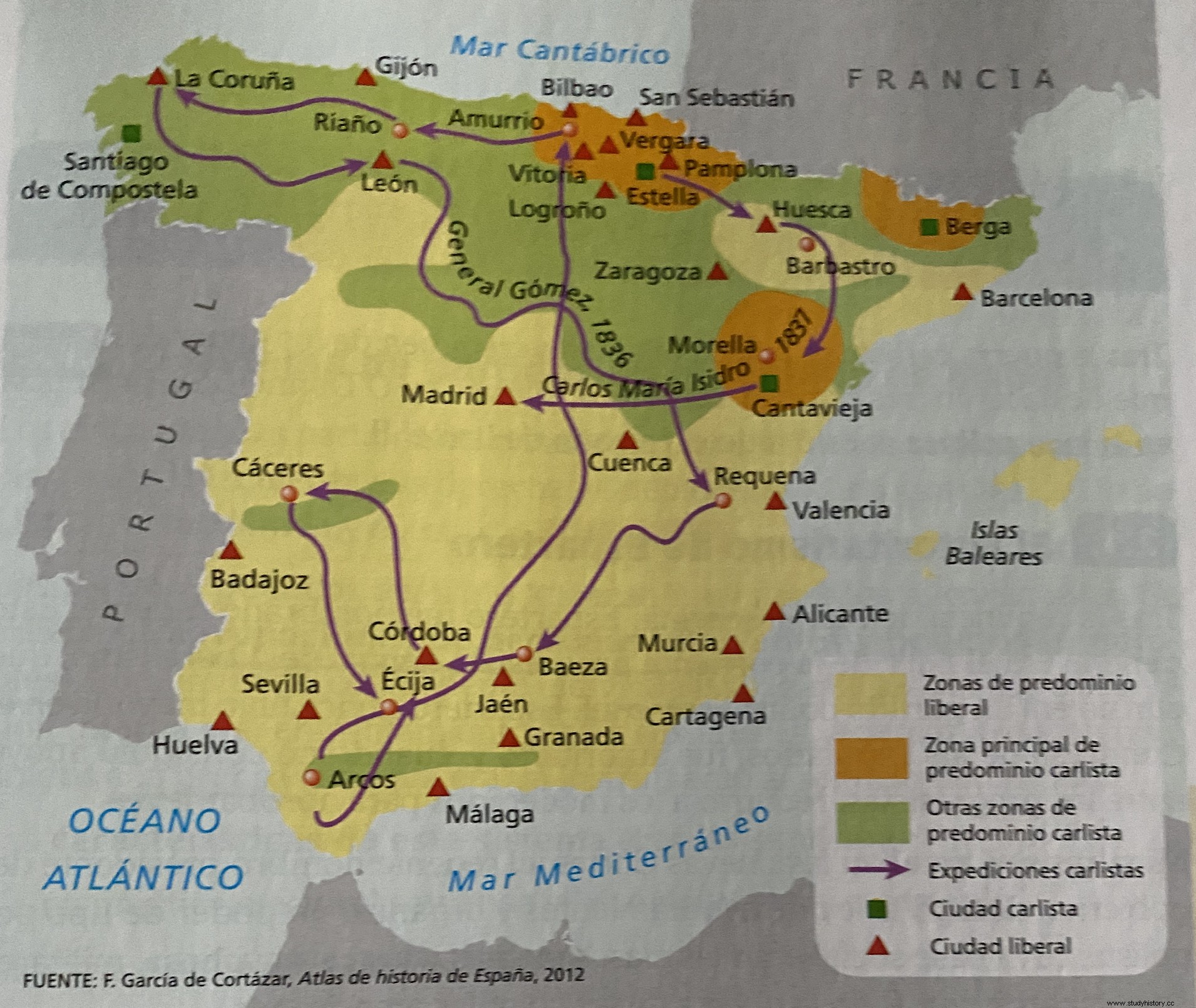
The third phase took place between October 1837 and August 1839. It saw the victory of the government troops. The Carlist defeat caused the appearance of a division in the movement:on the one hand, the most conservative Apostolics, in favor of continuing the struggle, and, on the other hand, the more moderate ones, who wanted a negotiation. This last position was imposed on the Carlist side, which allowed the signing of the Vergara Agreement (August 20, 1839) between Generals Espartero, of the Elizabethan army, and Maroto, of the Carlist. It promised the maintenance of the Basque privileges, a promise that Espartero failed to fulfill, and the integration into the Elizabethan army of the Carlist officers who wished it. The rejection of this agreement by the most conservative Carlist sector and by Don Carlos himself caused his exile in France and the prolongation of the war in Catalonia and Aragon until the final defeat of General Cabrera in Morella (June 1840). Q>
4. The war of the Matiners (1846-1849)
In 1846, the so-called «war of the Matiners began in Catalonia. » This armed conflict was not comparable to the other wars, neither for intensity, nor for duration, nor for the territory affected. In reality, the actions of the Carlist parties had not ceased in some territories –Maestrazgo, Catalonia– since the end of the first war. The formal reason for its beginning was the announcement of Isabella's marriage to her cousin Francisco de Asís, because this meant the failure of the project to resolve the dynastic conflict by marrying the queen to Carlos VI, son of Carlos Mª Isidro.
The uprising was gaining strength due to the effects of the economic crisis of 1847-1848. This explains why the Carlist military forces were made up of workers from small craft or manufacturing production, something peculiar to this war. To this must be added the opposition to the implementation of the consumption tax – a tax that was levied on the sale of products, including basic necessities, and that the buyer had to pay – and the rejection by young Catalans of “ fifths”.
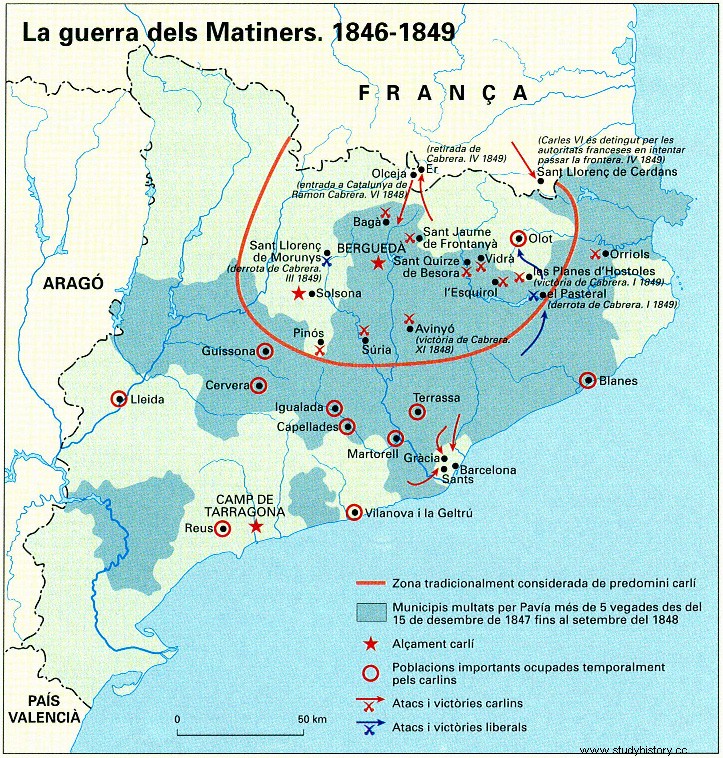
The coincidence of this uprising with the outbreak of the 1848 revolution in France led to a curious alliance of interests between Republicans and Carlists in Catalonia. But the failure to spread the movement to the rest of Spain heralded the decline of the insurrection. In the end, the fatigue caused by three years of war, the arrest in France of Charles VI and a certain economic recovery, ended the conflict.
5. The Carlist recomposition.
The political crisis of the Elizabethan regime and the European context favored the Carlist revival. Around 1860, Carlism seemed defeated. After two lost wars, the resignation of the two Carlist infantrymen to the rights of the throne and their exile, liberalism seemed to have definitively won. However, important geopolitical changes took place in Europe in the 1960s, transformations that ended up having repercussions in Spain. The territorial reduction of the Vatican State, within the framework of the formation of the Kingdom of Italy, mobilized European Catholicism against liberal principles. At the same time, two new powers were formed in Europe:the Second German Empire and the new Austro-Hungarian Empire, which adopted political formats similar to those proposed by the Carlists:monarchical, authoritarian and confederal states.
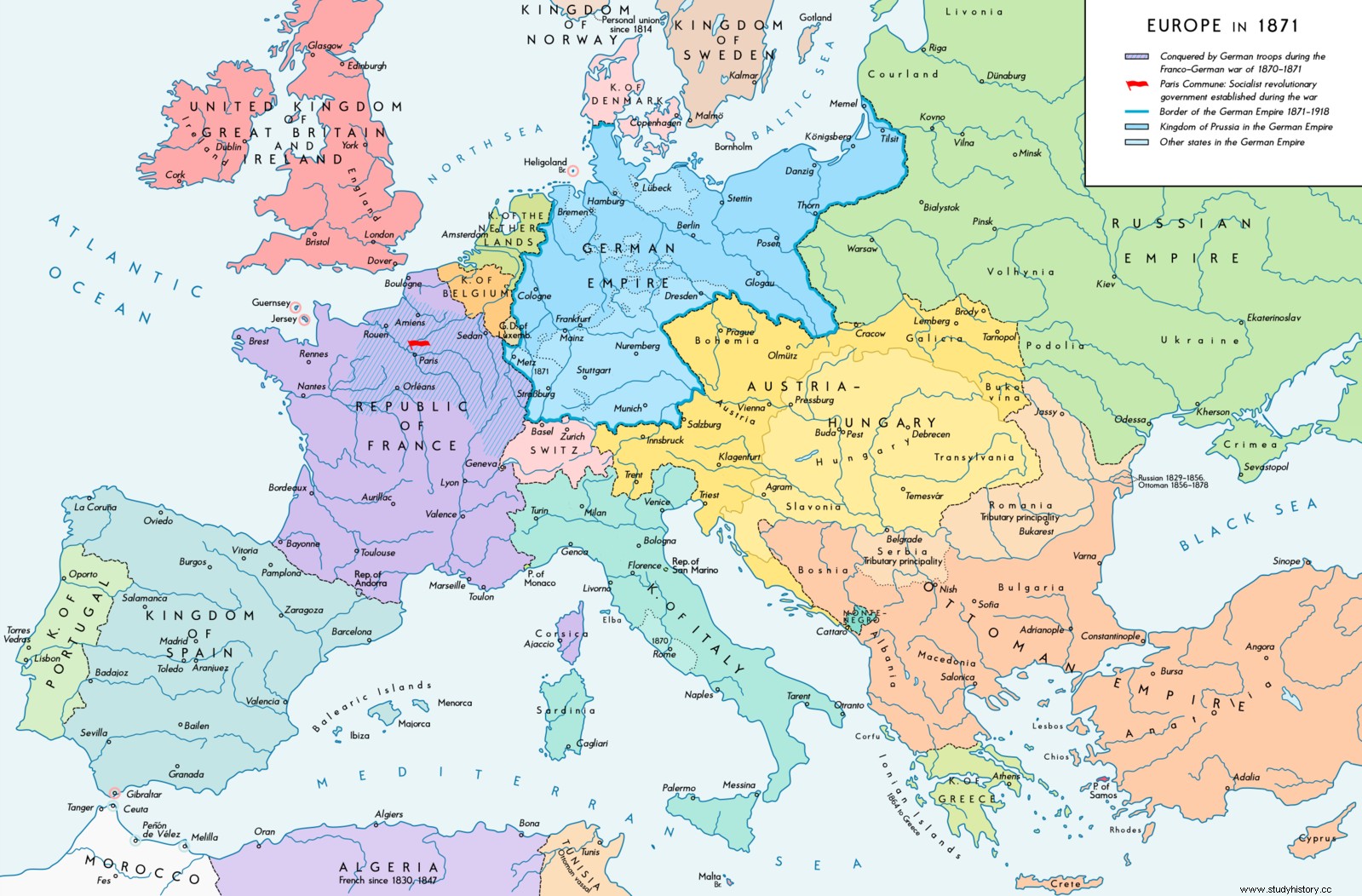
From Austria, inspired by these changes that favored her postulates, María Teresa de Braganza – who had been the second wife of the infant Carlos María Isidro – maneuvered so that, after the death of Carlos (Carlos VI), the Carlist succession would not fall to her. brother Juan de Borbón, of liberal ideas, but to go directly to his son, Carlos -Carlos VII-, who had never been to Spain.
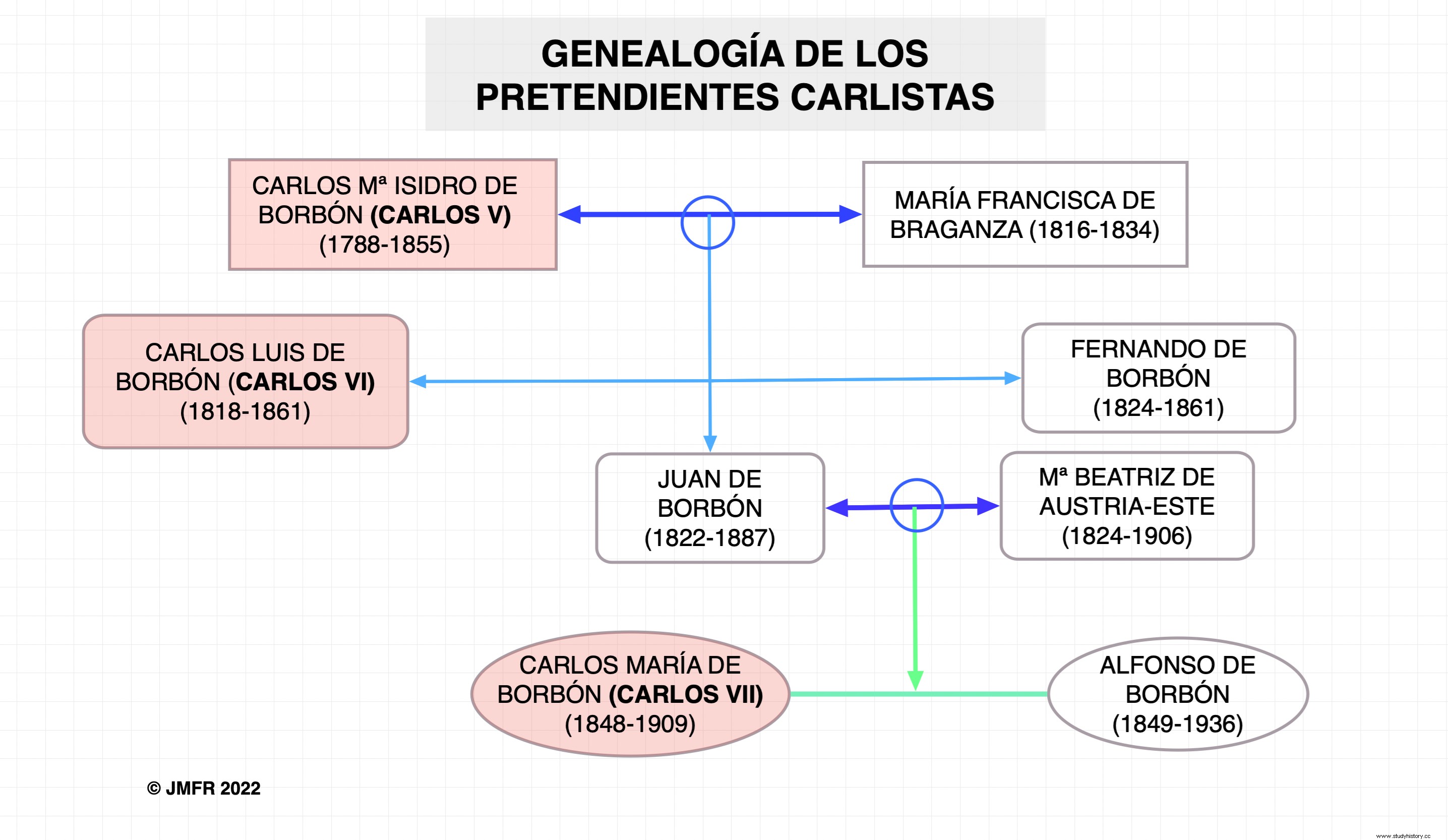
The Elizabethan liberal regime went into crisis in 1865 and in 1868 collapsed. In this period, the most conservative sector of the liberals left the regime and joined the reaction that was gaining strength in Europe. Catholicism was the central point of the reactionary ideology because it was assumed that the Catholic faith would guarantee the threatened social order, dilute political confrontations and reinforce the Hispanic identity. Under these premises, the new Carlist party, the Catholic-Monarchist Communion, was formed.
The party opted for participation in the electoral game and did so between 1869 and 1872. However, the results obtained in the various elections -in the constituent elections of 1869, the party only won 20 of the 359 seats at stake and, of them, , 17 were concentrated in the Basque provinces and Navarra; in the legislative elections of 1871, the Communion obtained 51 deputies out of 420 seats, although more distributed throughout the Spanish territory– Carlist expectations were disappointed. The electoral fiasco of the general elections of April 3, 1872 –38 deputies out of 391 seats– definitively banished the path of political participation and opened the path of armed uprising. The Carlists thus discovered that their electoral ceiling was low and that religion was not a powerful enough argument to sustain their confrontation against liberalism and republicanism.
6. The Second Carlist War (1872-1876).
With Carlos VII, already as Carlist leader, armed clashes began. A first attempted insurrection in 1872 failed due to lack of military support and the Carlists were defeated in Oroquieta by General Serrano. Peace came through the Amorebieta agreement, which granted the rebels a broad amnesty in exchange for ending hostilities. In Catalonia, however, the fight continued through the actions of various parties led by veterans of previous wars. This continuity prompted the Carlists to resume fighting in the Basque provinces and Navarra, although with low intensity.
The proclamation of the First Republic benefited the Carlist cause, which managed to increase its troops and support, especially in the territories indicated above. Various governmental military defeats made it possible for the Carlists to create an ephemeral state, since they came to control the three Basque provinces and a good part of Navarra, although not the capitals.
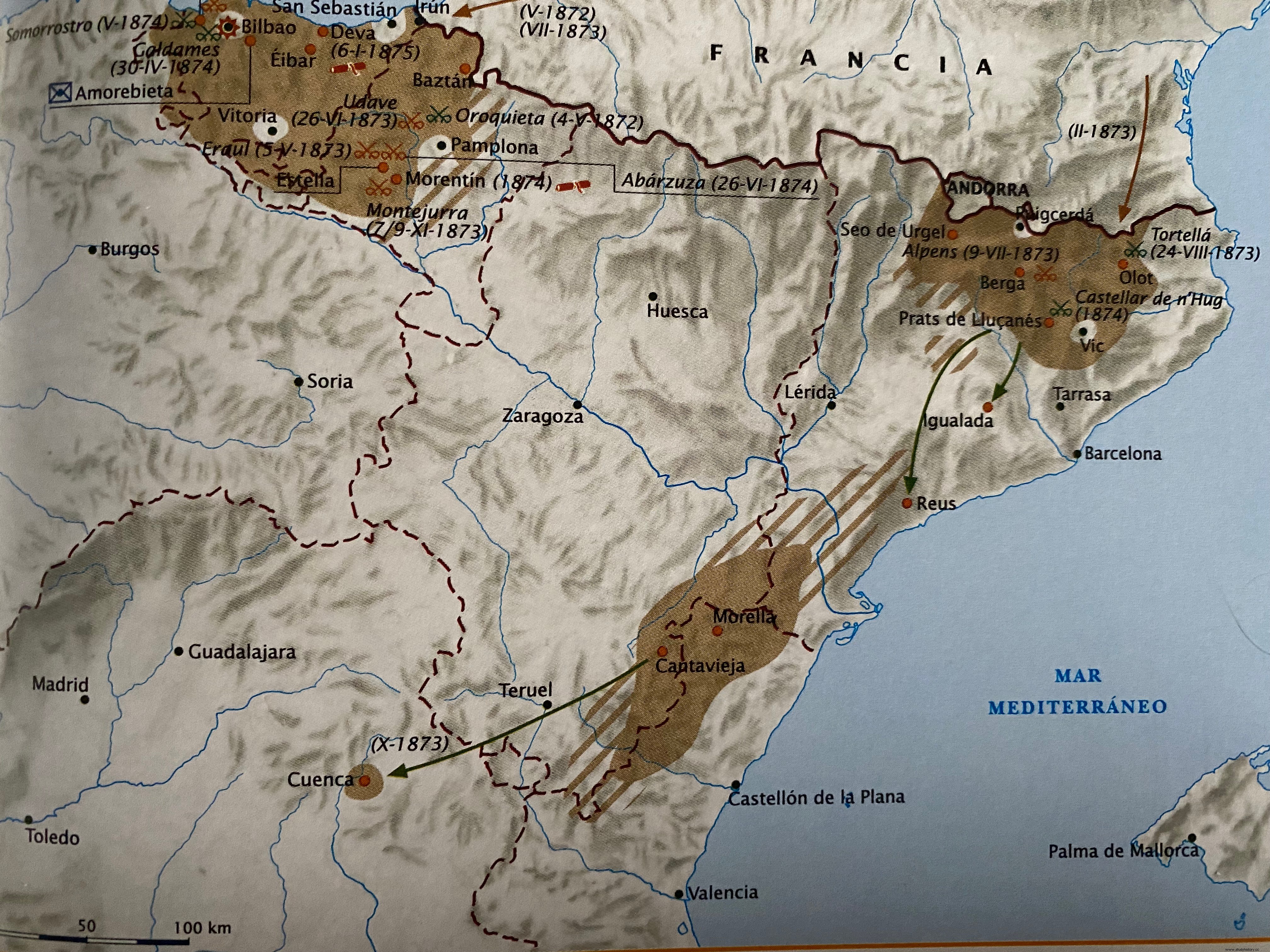
In Catalonia, the war continued through independent parties that practiced a very brutal guerrilla war and sabotage and extortion, but that did not allow them to control any territory in a stable way. To obtain more support, the Carlist leader in Catalonia, Alfonso Carlos (brother of Carlos VII) published a manifesto that offered to return the charters to Catalans, Aragonese and Valencians, a simple rhetorical gesture. The conflict also spread to areas of Castilla la Vieja, but the lack of economic resources, the cessation of French aid and the individualism of the military commanders, clearly showed that the Carlists could not maintain a war of attrition
The numerous problems of the republican governments – the war in Cuba, the cantonal insurrection, the abolition of the fifths, etc. – delayed the government's military response. But this situation changed with the Alfonsine Restoration (1875), which snatched from Carlism the monopoly of social conservatism and the defense of Catholicism. The political change also brought about a variation in the military situation, with the Carlist troops finally being defeated in Montejurra in 1876.
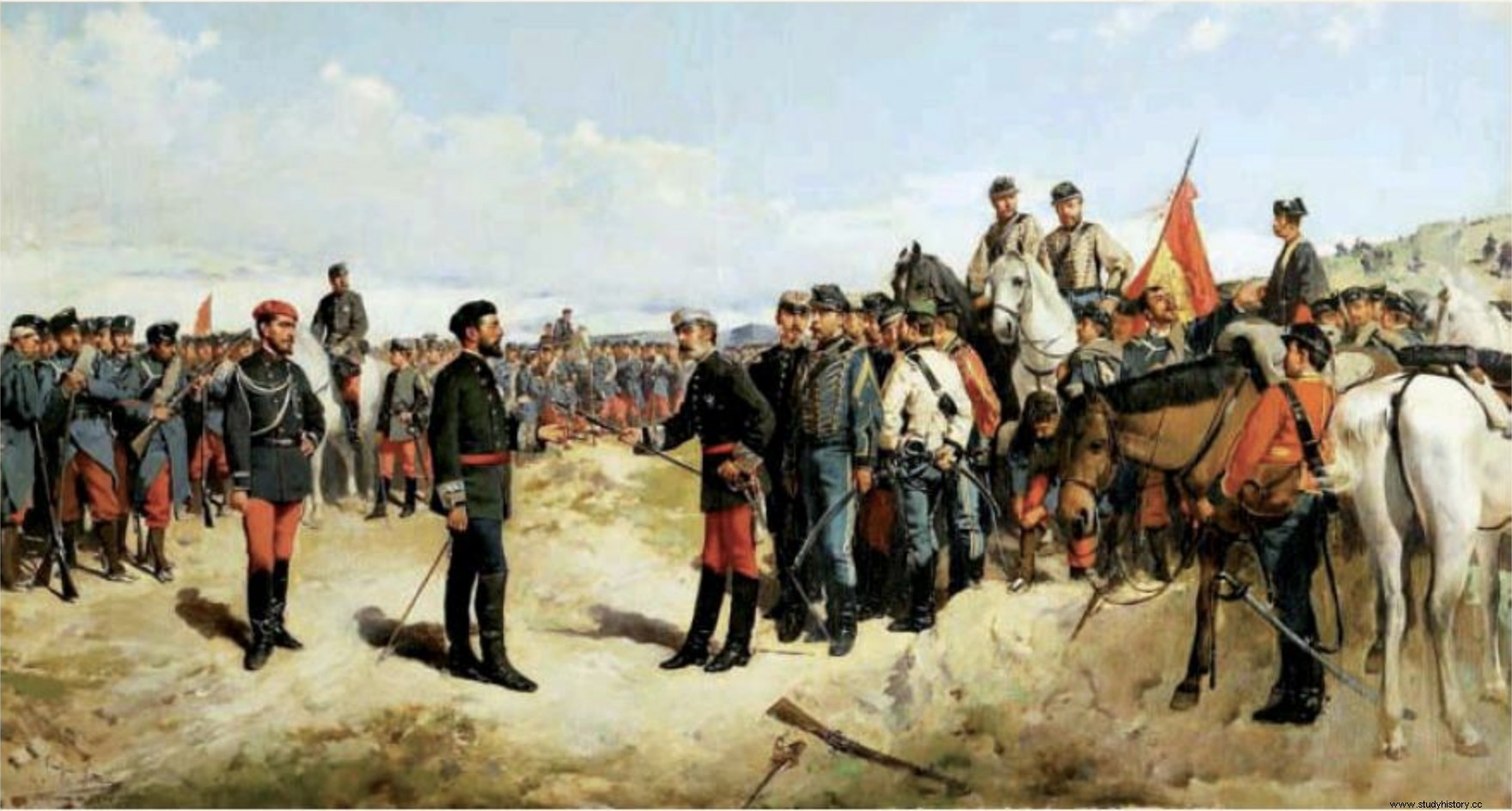
7. Conclusions.
Carlism was a political movement related to European traditionalism. The achievement of sufficient political and social support allowed him to provoke a conflict that bloodied the country for four decades and hindered its economic development. The main root of Carlism was the ideological rejection of liberalism and the governments of that sign, but its degree of legitimacy came from the dynastic options granted to it by the person of the infant Carlos María Isidro. Both his ideology and his political practice can be included within the concept of counterrevolution.
Thus, we are talking about an antiliberal and counterrevolutionary movement that emerged in the context of the crisis of the Old Regime and developed during the process of consolidation of the liberal governments in Spain, especially during the reign of Isabel II. Their survival lasted throughout the 20th century, resurfacing at crucial moments in the history of Spain during the 20th century, such as the Civil War –in which, under the name of requetés, they supported the military uprising– or the Democratic Transition –a stage in which the movement split.
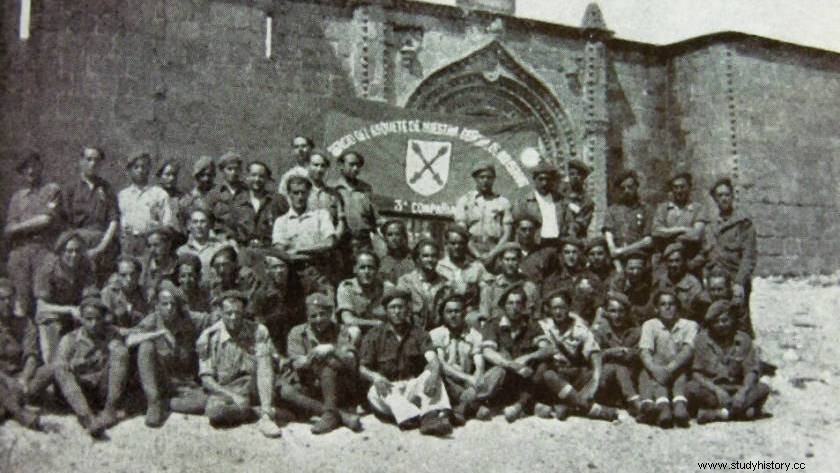
The ideological basis of Carlism was based, therefore, on the maintenance of tradition and the fight against liberalism. The foundations of his political thought can be synthesized in the motto Dios, Patria y Rey, to which the Fueros would later be added –understood as a case of traditional freedoms and privileges, with nothing to do with the current autonomist or nationalist tendencies. . Apart from these great framework ideas, the Carlist program was quite vague, a fact that facilitated the persistence of various factions. What can be affirmed is that it did not represent a simple return to the Old Regime but that it had its own ideology and project, albeit diffuse – for example, Carlism never committed itself to the reestablishment of the seigneurial jurisdiction, suppressed by the Cortes of Cádiz, nor did he question private property of a capitalist type.
The geography of Carlism remained almost unchanged during the 19th century, with only the volume of its support varying. The Carlist territory par excellence was in the north of the peninsula – the Basque Country, Navarra and Catalonia – with sporadically appearing nuclei in Valencia, Aragón and what was then known as Castilla La Vieja.
On a military level, guerrilla warfare –parties– and insurrections in the rural world were the most typical forms of Carlist violence. The independence and mobility of the parties were the keys to their success, but also a serious obstacle to their control, as well as a difficulty for their inclusion in a regular army. For this reason, on certain occasions, these games resulted in phenomena of simple delinquency or banditry.
Regarding its social base, research has shown that the main supporters came from ecclesiastical sectors, from the gentry or from ennobled owners who exercised their power –based on privilege– in local or regional spheres and who were threatened by some mechanisms of liberalism – disengagement, confiscations, tax demands or a representative political system based on elections. It is true that they also obtained certain support among the impoverished peasantry of the territories where it spread the most, in favor of a moral economy (associated with traditional economic forms) that was not compatible with the development of bourgeois property and capitalist agriculture, but his role was secondary.
The Carlist movement fits perfectly into the European context of the time. The fight against liberalism promoted a reaction that had manifestations in various European countries:in Portugal, miguelism; in Italy, the Viva Maria insurrections in Tuscany and the various movements of resistance to unification; in France, the legitimism of the Duchess of Berry and the Count of Chambord.
8. Bibliography
Channel, George (2005). Carlism and counterrevolution. The Adventure of History, 77. Dossier The Carlist puzzle.
Clemente, Josep C. (2011). Brief history of the Carlist wars . Madrid:Nowtilus.
Darde, Carlos (2022). Battles, sieges and guerrillas. The Adventure of History, 282. Dossier The last Carlist war.
Fernandez, J.M.; Gonzalez, J.; Leon, V.; Ramírez, G. (2016) History of Spain. Madrid:Santillana.
Fontana, Joseph (2007). The era of liberalism. History of Spain, vol 6. Barcelona:Critique-Marcial Pons.
Millan, Jesus (1998). A reconsideration of Carlism. Yesterday , 29.
Wheel, German (2022). Not just a dynastic problem. The Adventure of History, 282. Dossier The last Carlist war.
Rujula, Pedro (1998). Elites and social base:popular support in the First Carlist War. Vasconia, 26, 125-138.
Santirso, Manuel (2022). Carlist Renaissance. The Adventure of History, 282. Dossier The last Carlist war.
Urquijo, Jose R. (2005). blood orgy The Adventure of History, 77. Dossier The Carlist puzzle.
